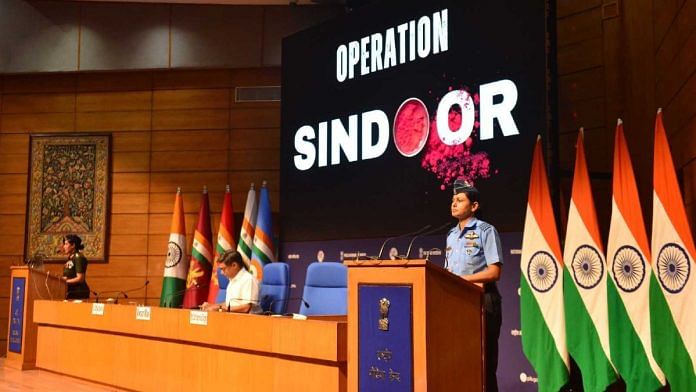Operation Sindoor was a three-night military operation from 7-10 May 2025. In the first phase, India launched coordinated air-launched missile and drone strikes against nine prominent terrorist locations in Pakistan-occupied Kashmir (PoK), as well as deep inside Pakistan. These precision strikes were unprecedented in the history of the India–Pakistan conflict.
The fact that the strikes were delivered almost simultaneously over a frontage of hundreds of kilometres—stretching from Muzaffarabad in PoK to Bahawalpur in Pakistani Punjab—within a short span of about 30 minutes, left both the Pakistani state and the terror groups stunned, with no time to react. Also, the fact that four target locations were in Pakistan, across the international border, and included the headquarters of terror groups like Jaish-e-Mohammed in Bahawalpur and Lashkar-e-Taiba in Muridke, was unimaginable for the Pakistani military, adding to the shock and awe.
Over the next two days, Pakistan tried to respond with waves of drone and missile strikes targeting India’s civilian and military infrastructure but was effectively thwarted by a well-integrated air defence system. In response, India took out Pakistan’s air defence systems and radars in prominent locations, including Lahore.
On the night of 9 May, India, exercising its right to respond, targeted 11 military airfields and other critical infrastructure in precision strikes across Pakistan, severely crippling its air power capability. Shocked and devastated by the damage inflicted, Pakistan was quick to request a ceasefire on 10 May, which India accepted.
The ceasefire ended the conflict, which is being termed by many commentators as one of the shortest and most effective military operations in modern history. A brief look at other recent conflicts in the world would give a better understanding and perhaps an appreciation of the military might and precision demonstrated by India in Operation Sindoor.
The Gaza War, which commenced on 7 October 2023, triggered by a terror attack by Hamas into Israel, has been going on for over 20 months and shows no signs of ending. Reason? Despite a number of occasions when Israel was clearly ascendant and militarily dominant, it has not been able to call it off. To most military observers, it stems from two reasons. Firstly, the military objectives—which include ‘eliminating Hamas from the face of the Earth forever’—are deemed unrealistic and difficult to accomplish on the ground. Secondly, on several occasions, a lack of synergy and growing discontent between the military, intelligence, and political leadership has come to the fore, leading to confused decision-making and stretched timelines.
Then there’s the Russia-Ukraine War, which broke out on 24 February 2022 after Russia launched ‘Special Military Operations’ against Ukraine. Despite initial claims that Russia would achieve its politico-military objectives in 20-30 days, the conflict continues even three years on with no immediate signs of resolution. Reason? Russia had three stated objectives: demilitarisation of Ukraine, denazification of Ukraine, and the declaration of independence of Russian-speaking areas, especially Donetsk and Luhansk. Although Russia has been dominant for the most part during these three years of conflict, the challenge has been to translate these objectives into clearly defined targets for the military to strike and capture. How does a military achieve the aim demilitarisation or denazification? Obviously, military support from Europe and the US has also contributed to the continuation of the conflict.
When discussing long-drawn conflicts, the US-led war in Afghanistan cannot be left out. A war which began with targeting Al Qaeda bases to avenge the 9/11 terror attack soon morphed into a war against the Taliban, gradually moving into the space of political stabilisation and training Afghan military forces to defend themselves. Result? An unending campaign with no clearly defined objectives, which finally came to a close with the embarrassing overnight pullout of American forces in August 2021, leaving the Afghans at the mercy of the Taliban.
Many other military campaigns ended a similar manner, like the war in Yemen, which went on for eight years, from March 2015 to March 2023, and still left the Houthis in charge.
The bottom line is that most countries have found it easy to get into a military conflict, but have not been able to devise a successful and effective exit strategy.
Operation Sindoor avoided many of the pitfalls of other conflicts around the world.
Clearly defined military objectives. The operation was launched to target the terrorist outfits behind the Pahalgam attack. In striking nine locations in Pakistan, the Indian armed forces were precise in converting the military objective into action. The subsequent strikes on air defence targets and air bases in Pakistan were also based on clearly defined directions to strike back in response, and harder than the Pakistani effort. At no point did the military objectives stretch to include other possibilities like extending this operation to resolve territorial issues in PoK or Pakistan by undertaking ground operations or using naval forces for active kinetic action. This was a very important factor in enabling an early ceasefire.
Strong and decisive political directives. In a country where terror strikes such as the Parliament attack in 2001 or 26/11 in Mumbai went unanswered, the scale, might, and depth of Operation Sindoor was an astonishing signal of political intent. The precise directive given to the armed forces, and the freedom to convert that political intent into military action, was a key factor in bringing down heavy punishment on terror groups and military infrastructure in Pakistan.
Synergy and ‘whole of nation’ approach. Operation Sindoor was a textbook example of synergy between the Army, Navy, Air Force, and even the Border Security Force and other security and intelligence agencies. Selection of targets, timely corroboration of intelligence by multiple sources, evacuation of citizens in Indian border areas to safer places, and vigilance to ensure that communal harmony within the country was not disturbed—all were conducted with great synergy and inter-agency coordination, leading to speedy achievement of military objectives with minimum losses.
Selection and maintenance of aim (target). By carefully selecting the nine locations critical to terror infrastructure in Pakistan on 7 May, the air defence systems on 8 May, and thereafter the 11 air bases on 9 May, the Indian armed forces displayed exceptional focus in applying a very important principle of war: ‘selection and maintenance of aim’. This was also a major contributory factor in the early declaration of ceasefire.
Non-escalatory nature of operations. Right from the outset, India maintained a clear position that the objective was to target terror infrastructure, and that Pakistani military or civilian infrastructure was not a part of the war objectives. This was reiterated even after the strikes on Pakistan air defences and air bases, making it easier for India to accept Pakistan’s plea for an early ceasefire.
Keeping the operations below the nuclear threshold. India kept the threat of Pakistan using nuclear weapons in mind while planning and executing operations. By not targeting any civilian areas or key civilian or military infrastructure (except air bases, that too in response to Pakistani air raids), and by not launching ground incursions deep into Pakistani territory or a naval blockade, India did not let Pakistan play victim or find grounds to explore the use of nuclear weapons.
Operation Sindoor was not only a successful military operation but has set many benchmarks for the world to follow. Among post–World War 2 conflicts, only the Six-Day War of June 1967, fought between Israel and the Arab countries, comes close to such a bold, decisive, and swift military campaign.
Therefore, Operation Sindoor will be studied, analysed, and remembered not only for its military precision and strong political intent but also for ending quickly, from a position of huge military and political advantage. It will definitely be remembered as a major turning point in India’s fight against terror and as a display of India’s military prowess and professionalism.
(Edited by Asavari Singh)








